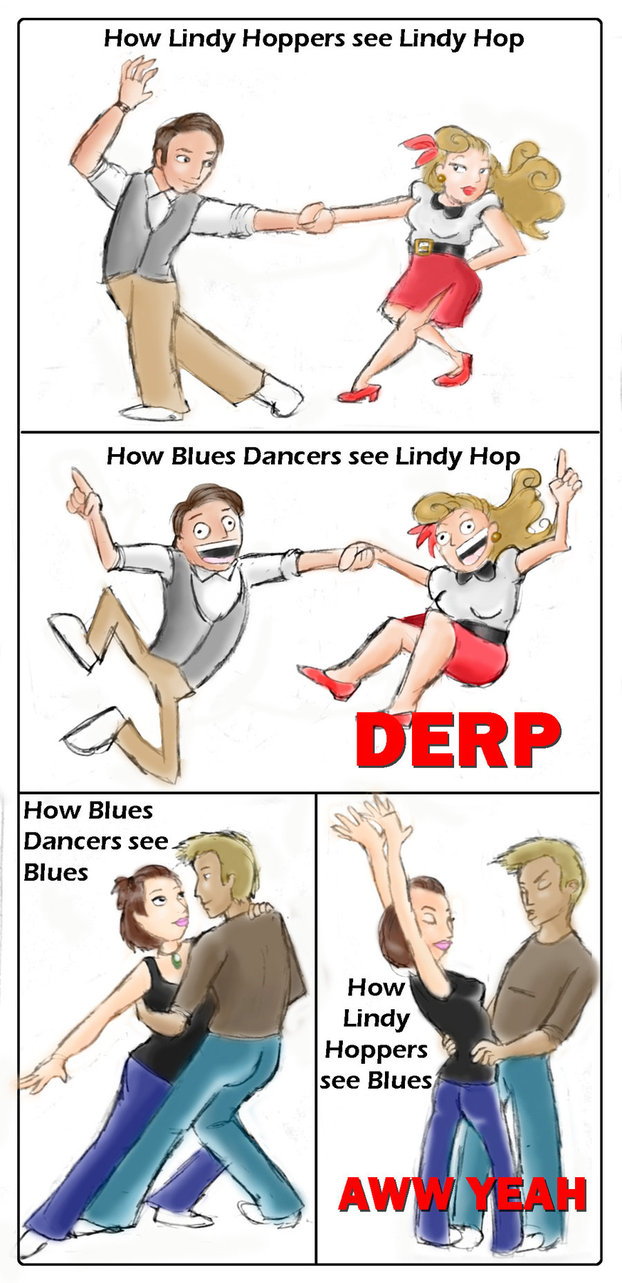A few weeks ago, I was writing down some notes of ideas I want to do within my local dance scene to help us get past some issues we have been having. When I wrote them, we were going through a hard time, I was having a hard night and left early accidentally leaving it behind. Upon returning for the weekly dance, I looked for those notes and found this.

Now, although I’m not technically positive it was a swing dance member who wrote on my notes, the feud between the two dances is long-standing and, frankly, a little ridiculous. Regardless of if these notes and drawings were meant to just be funny, it shows an underlying issue that needs to be discussed. Somewhere in the last seven years, if not on the conception of the modern blues community, the style is known as blues dancing was being disrespected by swing. And in reaction to that, many blues dancers, feeling rejected and isolated, have begun to disrespect swing dance. Ironically, swing dancing is mocked by other dances.
Several years ago, I first started dancing with swing dancing, like many blues dancers. At my first exchange, many of my friends would put their noses up at the idea of attending the late night dance or going into the side room which was “blues”. They whispered about it in the same way that my Ohio friends whisper about the slutty girl behind her back. When I went into the side room for the first time, I sat and watched and simply noticed that it was a more intimate dance, and nothing more. Upon trying it, I found myself enjoying it, and felt weird knowing many of the people I was staying with found it distasteful. Over time,I found myself more and more enamored by the blues room. They didn’t always play songs I recognized, but occasionally I would hear songs come on from my chair outside, and it would feel so nice to be able to dance to things that were familiar to me and connected me to important people in my life. Swing was fun, and I never understood the drama between the two.
As I slowly became a better dancer, I started noticing I was feeling pressure within swing dance community to act and dress a certain way. The problem was, because I was Black, it was difficult and more expensive to do so. I felt like blues community did not require that of me and over time, started playing more and more music that was familiar to me. The deeper I dove in the blues, the more people I found that thought that blues was a dirty dance, that it was the place of sexual assault, discomfort, noodle dancing. I regularly hear disparaging comments, such as “blues dancing is doing whatever you want”, “I don’t want to feel like I’m having sex on the dance floor,” and that blues dancing was only for house parties and side rooms; it was not a real dance. It was hard because I had taken classes in Blues, and I found I learned a lot, and yet many of my dance friends did not respect what I was doing. Not long after, I decided I wanted to be an instructor one day and started looking into the history of blues.
I found that the history was much more complex than I had been originally informed. It was not a dance that was created by drunken Lindy hoppers dancing at house parties await to get their groove on, but was instead a dance with a rich history within African-American community. Blues dancing was a large family of dances that were created at different points in blues history, and many of us simply did not know about it. Upon realizing that blues dancing was an African-American dance, I began to become curious as to why I felt uncomfortable there, but even more uncomfortable within the Lindy hop community. I became very inspired to tell everyone about that the dances we were doing were made by Black people. I became inspired to tell them why this mattered, how it affected my dancing, and why people seemed to believe that me being a natural was really just cultural. I found that my Lindy hop friends seemed interested in acknowledging that fact surrounding Lindy hop but did not believe me when it came to blues. They told me I was wrong and being brainwashed, that blues was nothing more than an excuse for people to be inappropriate. I was not the only one. This, among many things, was part of the cause of the split between Lindy hop and blues. Blues began to have separate events, competitions, and instructors.

Still, many years later, these prejudices remain in our community. Much of the Swing dance community stays intentionally ignorant around its Black roots and the importance of that, while the blues community is attempting to rectify that. Over time, the blues community rejected the swing dancing community, I think, mostly because of feeling tired of having their dance style disrespected. Sadly, I see the same thing happening within the blues community towards the fusion community. We are becoming the bullies that we see in the swing community towards blues dancers. When I was a younger dancer, I was infuriated by the way the Lindy hop scene ridiculed blues dancing. Today, I’m simply saddened. These two dance styles are beautiful styles that are connected to similar musics and created by the same people, and yet it’s people outside the culture that created divisions and made assumptions about what is not appropriate. In doing so, they changed the dance they say they love into something robotic and still feel a need to look down other styles. Instead of attending a class, learning from an expert, they choose to belittle something that their own dance came out of,whether they choose to recognize the history or not. A lot of times, I actually missed Lindy hop, yet I hesitate to go back on a more regular basis until I feel that my primary dance is respected with as much respect as I give to the dance of Lindy hop.
If you like this writing consider joining our patreon community. you get cool perks and help this site continue!.
if that doesn’t work for you, consider buying a cuppa coffee for the author. ko-fi.com/H2H7E6LU
